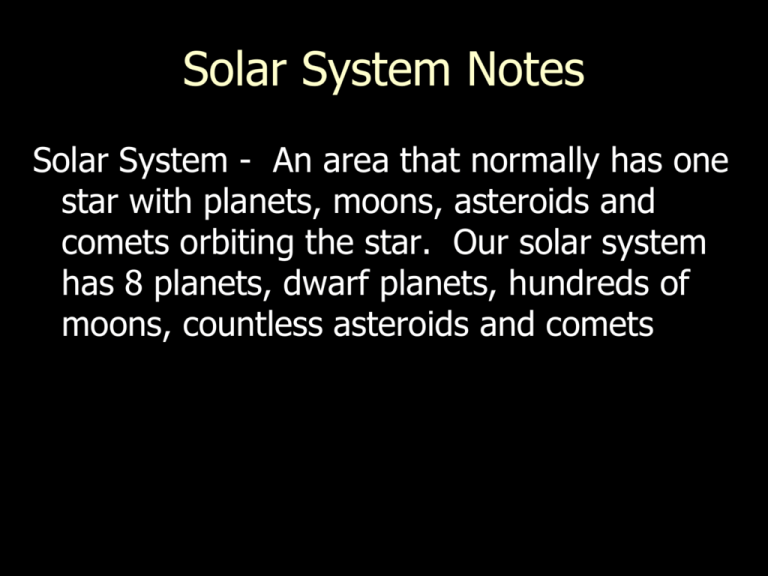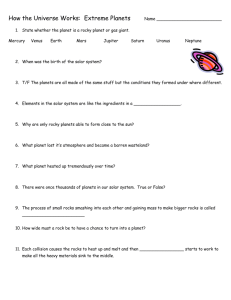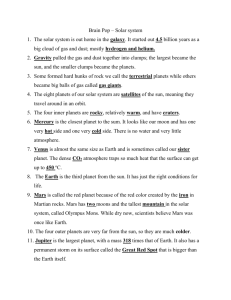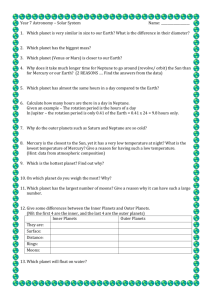Planet Flash Cards
advertisement

Solar System Notes Solar System - An area that normally has one star with planets, moons, asteroids and comets orbiting the star. Our solar system has 8 planets, dwarf planets, hundreds of moons, countless asteroids and comets Solar System Formation 1. Was a giant Nebula (cloud of gas and dust) 2. Nearby explosion caused it to start spinning 3. Most of the stuff pulled to center (the sun) 4. Remaining stuff continued spinning around sun – planets, comet, asteroids The Order of the Planets ► 1. ► 2. ► 3. ► 4. ► 5. ► 6. ► 7. ► 8. Mercury Venus Earth Mars Jupiter Saturn Uranus Neptune 1. My 2. Very 3. Educated 4. Mother 5. Just 6. Served 7. Us 8. Nachos Compare the size of the Sun to all 8 Planets! Compare the sizes of the Terrestrial Planets: Mercury: ► Closest to the Sun ► Shortest Revolution ► Terrestrial Planet –Rocky Surface ► Inner Planet ► No Moons ► 1 day = 58 Earth days ► 1 year = 88 Earth days – shortest year Venus: ► Close in size, mass and density to Earth ► “Earth’s Twin” ► Hottest Average Temp. ► No Moon ► Retrograde Rotation – Spins backwards ► Inner planet ► Terrestrial Planet ► 1 day = 243 days – longest day – longer than year ► 1 year = 224 days Earth: ►1 moon (Luna) ► Has liquid water ► Has the only known life ► Inner planet ► Terrestrial planet ► Revolution = 365.25 days ► Rotation = 24 hours ► Prograde Rotation Mars: ►2 Moons ► Thin Atmosphere ► The “Red Planet” ► Smaller than Earth ► Terrestrial planet (inner planet) ► 1 day = 24.5 hours ► 1 year = 687 days Compare the sizes of the Gas Giants Jupiter ► Largest Planet ► Made mostly of H and He ► Many moons (about 66) ► Has a red spot (1.5 X the diameter of Earth) ► Gas Giant – No Solid Surface ► Has a few rings. ► 1 day = 10 hours – shortest day ► 1 year = 12 Earth years Saturn: ► Made mostly of H and He ► Many moons (about 62) ► Less dense than water would float in a tub. ► Largest rings ► Gas Giant – no Solid surface ► 1 day = 10.5 hours ► 1 year = 29.5 years Uranus: ► Much smaller than Jupiter and Saturn ► Tilted at a 90 degree angle ► Has many moons (27) ► Retrograde rotation – spins backwards ► Gas Giant – No Solid Surface ► Has Rings ► 1 day = 18 hours ► 1 year = 84 years Neptune: ► Much smaller than Jupiter and Saturn ► Many moons (13) ► Gas Giant – No Solid Surface ► Has a few rings ► 1 day = 19 hours ► 1 year = 168.8 years – longest year Pluto (No longer a “planet”) ► Dwarf Planet ► 1 moon which is more than half the size of Pluto (they orbit around each other). ► Orbit is so elliptical that it’s path is inside Neptune’s for 20 years ► It just became last again in 2005. A dwarf planet is a celestial body that: 1. Orbits the sun. 2. Has enough mass to assume a nearly round shape. 3. Has not cleared the neighborhood around its orbit. 4. Is not a moon. The main distinction between a dwarf planet and a planet is that planets have cleared their path around the sun while dwarf planets tend to orbit in elliptical paths that cross each other. Ceres is in Asteroid Belt between Mars and Jupiter. “Plutoids” are Dwarf Planets that orbit out beyond Pluto. Smaller Objects Asteroids - Rocky, metallic objects that orbit the sun, normally in an orbit similar to a planet Comet – Made of ice and rock. It’s orbit takes it close to the sun and then very far. As it gets close, comet starts to melt creating a tail Not to Scale Asteroid Belt Smaller Objects Meteor - A piece of rock from space that enters Earth’s atmosphere and burns, creating a bright streak of light across the sky. (shooting star) Meteoroid – A small, broken up pieces of asteroids or comets. Meteorite – A piece of rock that lands on the Earth.









